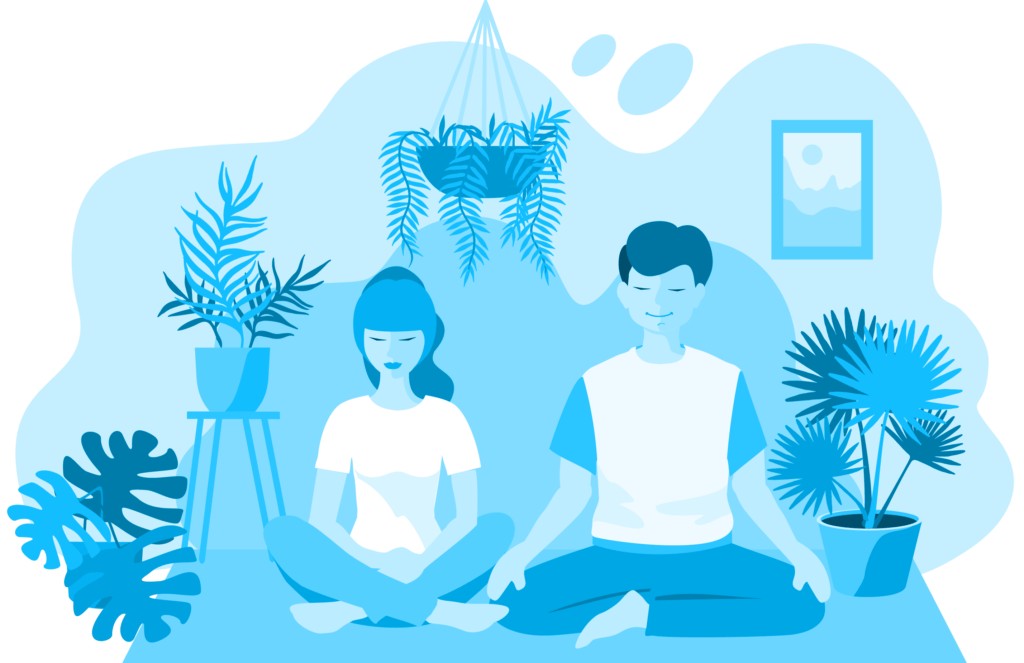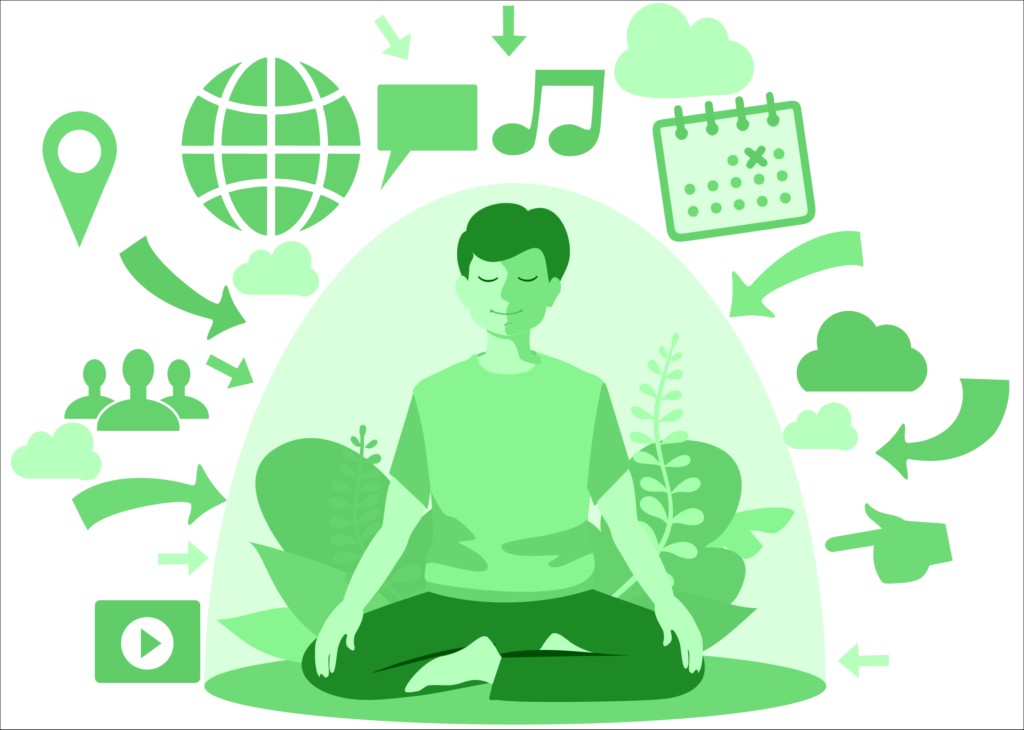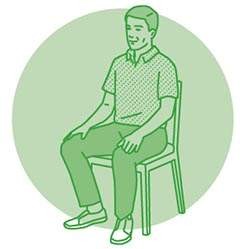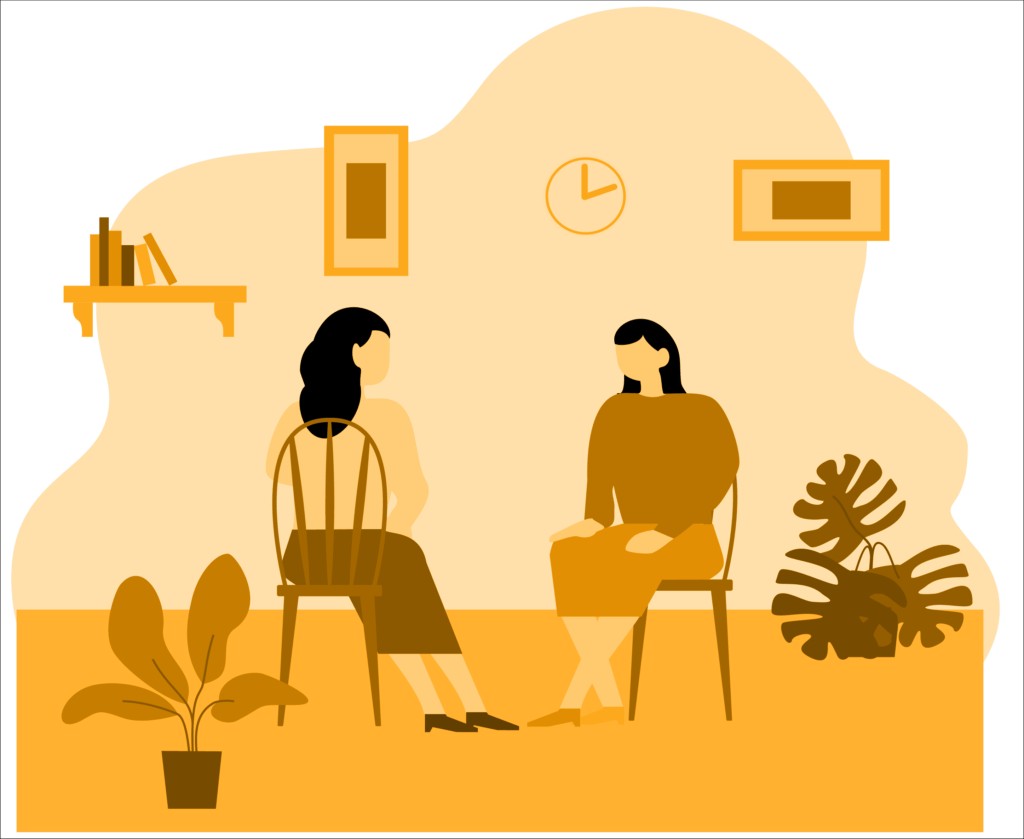Are you seeking inner peace and mental clarity? How To Learn Meditation is a journey towards mindfulness and self-awareness, a skill that LEARNS.EDU.VN can help you master. Discover the transformative power of meditation techniques and unlock a new level of well-being. Find relaxation methods, cultivate serenity, and foster a calm mind with our expert guidance.
1. Understanding Meditation: What It Is and Why It Matters
Meditation, at its core, is a practice of training your mind to focus and redirect your thoughts. It’s a technique used to cultivate mindfulness, a state of active, open attention on the present. The purpose of meditation isn’t necessarily to achieve a blank mind, but rather to observe your thoughts and feelings without judgment. As Jon Kabat-Zinn, the founder of Mindfulness-Based Stress Reduction (MBSR), puts it, “Mindfulness means paying attention in a particular way; on purpose, in the present moment, and non-judgmentally.”
Meditation is not just about relaxation; it’s a powerful tool for enhancing your overall well-being. The benefits of meditation are vast and well-documented, supported by numerous studies and the experiences of countless individuals. By learning how to meditate, you can unlock a new level of mental clarity, emotional resilience, and inner peace.
1.1 Defining Meditation
To define meditation more explicitly, it is a process that trains your mind to concentrate and redirect your thoughts. According to the American Psychological Association, meditation is a mental exercise that involves relaxing the body and focusing the mind on a particular stimulus, such as a sound, image, or the breath. This practice helps in reducing stress, improving focus, and enhancing self-awareness.
1.2 Key Elements of Meditation
- Focus: The ability to direct your attention to a specific point, whether it’s your breath, a mantra, or a sensory experience.
- Mindfulness: Being present in the moment, observing your thoughts and feelings without judgment.
- Non-Judgment: Accepting your thoughts and feelings as they are, without labeling them as good or bad.
- Relaxation: Achieving a state of calm and physical relaxation.
1.3 The Science-Backed Benefits of Meditation
| Benefit | Description | Supporting Evidence |
|---|---|---|
| Stress Reduction | Meditation helps lower cortisol levels, reducing the physiological response to stress. | A study published in the “Journal of the American Medical Association (JAMA)” found that mindfulness meditation significantly reduced stress levels in participants. |
| Improved Focus & Attention | Regular meditation practice enhances the brain’s ability to focus and sustain attention. | Research at the University of California, Davis, demonstrated that meditation increases gray matter in the brain regions associated with attention and focus. |
| Enhanced Emotional Health | Meditation cultivates a more positive and balanced mindset, improving mood and reducing symptoms of anxiety and depression. | A meta-analysis in the “Journal of Consulting and Clinical Psychology” showed that mindfulness-based therapies are effective in treating anxiety and mood disorders. |
| Increased Self-Awareness | Through meditation, you gain a deeper understanding of your thoughts, emotions, and behaviors. | Studies using fMRI have shown that meditation increases activity in the brain regions associated with self-awareness and introspection, such as the medial prefrontal cortex. |
| Better Sleep Quality | Meditation can relax the mind and body, making it easier to fall asleep and improve sleep quality. | A study in “JAMA Internal Medicine” found that mindfulness meditation improved sleep quality in older adults with moderate sleep disturbances. |
| Strengthened Immunity | Regular meditation practice can strengthen the immune system, helping your body resist illness and recover more quickly. | Research at the University of Wisconsin-Madison found that meditation increases the production of antibodies in response to the flu vaccine, indicating a stronger immune response. |
| Increased Mental Resilience | Meditation helps build mental resilience, allowing you to better cope with challenges and setbacks in life. | Studies have shown that meditation increases the size of the hippocampus, the brain region associated with learning and memory, which is crucial for building resilience. |







2. Why Learn How to Meditate?
The benefits of meditation extend far beyond mere relaxation. Regular meditation practice can significantly improve your physical, mental, and emotional well-being. It’s a tool that empowers you to navigate the challenges of life with greater ease and resilience.
2.1 Top 10 Compelling Reasons to Meditate
- Understanding Your Pain: Meditation enhances your awareness of physical and emotional pain, allowing you to address it with greater clarity and compassion.
- Lower Your Stress: Regular meditation practice significantly reduces stress levels, helping you feel calmer and more relaxed.
- Connect Better: Meditation improves your relationships and communication with others by enhancing mindfulness and empathy.
- Improve Focus: Meditation trains your mind to concentrate better, improving your ability to stay focused and productive.
- Reduce Brain Chatter: Meditation quiets the constant noise and mental clutter, leading to a clearer, more peaceful mind.
- Enhance Emotional Health: Meditation fosters a more positive and balanced mindset, improving your mood and outlook on life.
- Increase Self-Awareness: Meditation provides deeper insights into your thoughts, emotions, and behaviors, leading to greater self-understanding and personal growth.
- Promote Better Sleep: Meditation relaxes the mind and body, making it easier to fall asleep and improve sleep quality.
- Boost Immunity: Regular meditation practice strengthens your immune system, helping your body resist illness.
- Support Mental Resilience: Meditation builds mental resilience, helping you cope with challenges and setbacks more effectively.
3. How to Meditate: A Step-by-Step Guide
Meditation is a skill that anyone can learn, regardless of age, background, or experience. While there are many different types of meditation, the basic principles remain the same. This step-by-step guide will walk you through the fundamentals of meditation, providing you with the tools you need to start your own practice.
3.1 Setting the Stage: Preparing for Meditation
3.1.1 Find a Quiet Place
Choose a location where you can sit or lie down without being disturbed. This could be a quiet room in your home, a peaceful spot in nature, or any other place where you feel comfortable and relaxed.
3.1.2 Set a Time Limit
If you’re new to meditation, start with short sessions of 5 to 10 minutes. As you become more comfortable with the practice, you can gradually increase the duration.
3.1.3 Comfortable Posture
You can sit in a chair with your feet on the floor, sit cross-legged on a cushion, or kneel. The most important thing is to maintain a posture that is stable and comfortable for you.
3.1.4 Minimizing Distractions
- Turn off notifications: Silence your phone and other devices to avoid interruptions.
- Inform others: Let your family or housemates know that you need some quiet time.
- Use earplugs or noise-canceling headphones: If you’re in a noisy environment, these can help block out distractions.
3.2 The Meditation Process: A Simple Practice
- Take a Seat: Find a place to sit that feels calm and quiet to you.
:max_bytes(150000):strip_icc()/ways-to-practice-mindfulness-meditation-3024944-FINAL-0e9992f3a6814c86a075c57cf4893a76.png)
-
Set a Time Limit: If you’re just beginning, it can help to choose a short time, such as five or 10 minutes. Use a timer or meditation app to avoid constantly checking the time.
-
Notice Your Body: You can sit in a chair with your feet on the floor, you can sit loosely cross-legged, you can kneel—all are fine. Just make sure you are stable and in a position you can stay in for a while.
-
Feel Your Breath: Follow the sensation of your breath as it goes in and as it goes out. Pay attention to the rise and fall of your chest or abdomen, or the sensation of air passing through your nostrils.
-
Notice When Your Mind Has Wandered: Inevitably, your attention will leave the breath and wander to other places. When you get around to noticing that your mind has wandered—in a few seconds, a minute, five minutes—simply return your attention to the breath. Acknowledge the thought or feeling without judgment, and gently redirect your focus back to your breath.
-
Be Kind to Your Wandering Mind: Don’t judge yourself or obsess over the thoughts’ content you find yourself lost in. Just come back.
:max_bytes(150000):strip_icc()/things-to-know-about-mindfulness-meditation-3024920-FINAL-42a5033916474277ad810ddb262514d1.png)
- Close With Kindness: When you’re ready, gently lift your gaze (if your eyes are closed, open them). Take a moment and notice any sounds in the environment. Notice how your body feels right now. Notice your thoughts and emotions.
4. Making Mindfulness a Habit: Tips and Techniques
Mindfulness meditation is the exact opposite of autopilot. It’s executive control rather than autopilot and enables intentional actions, willpower, and decisions. But that takes practice. The more we activate the intentional brain, the stronger it gets. Every time we do something deliberate and new, we stimulate neuroplasticity, activating our grey matter, which is full of newly sprouted neurons that have not yet been groomed for “autopilot” brain.
Here are some ways to get started:
- Put Meditation Reminders Around You: If you intend to do some yoga or to meditate, put your yoga mat or your meditation cushion in the middle of your floor so you can’t miss it as you walk by.
- Refresh Your Reminders Regularly: Say you decide to use sticky notes to remind yourself of a new intention. That might work for about a week, but then your autopilot brain and old habits take over again. Try writing new notes to yourself; add variety or make them funny. That way they’ll stick with you longer.
- Create New Patterns: You could try a series of “If this, then that” messages to create easy reminders to shift into the intentional brain. For instance, you might come up with, “If office door, then deep breath,” as a way to shift into mindfulness as you are about to start your workday. Or, “If phone rings, take a breath before answering.” Each intentional action to shift into mindfulness will strengthen your intentional brain.
| Strategy | Description | Example |
|---|---|---|
| Reminder Placement | Strategically position visual cues to prompt meditation practice. | Place a meditation cushion in a visible spot in your living room. |
| Regular Refreshments | Keep meditation reminders fresh and engaging to prevent habituation. | Change the color or wording of sticky notes used as reminders. |
| Pattern Creation | Develop “If this, then that” messages to link specific actions with mindfulness. | “If I open my email, then I’ll take three deep breaths before responding.” |
| Integrate with routines | Integrate meditation into existing routines to turn into a habitual practice | Meditate for 5 minutes right after drinking your coffee in the morning. |
5. Exploring Different Types of Meditation
Meditation isn’t a one-size-fits-all practice. There are many different types of meditation, each with its own unique focus and techniques. Experimenting with different styles can help you find the one that resonates best with you.
:max_bytes(150000):strip_icc()/types-of-meditation-4684173-FINAL-44755f1c382147a1853543f768751f3a.png)
5.1 A Basic Meditation for Beginners
The first thing to clarify: What we’re doing here is aiming for mindfulness, not some process that magically wipes your mind clear from the countless and endless thoughts that erupt and ping constantly in our brains. We’re just practicing bringing our attention to our breath, and then back to the breath when we notice our attention has wandered.
- Get comfortable and prepare to sit still for a few minutes. After you stop reading this, you’re going to simply focus on your own natural inhaling and exhaling of breath.
- Focus on your breath. Where do you feel your breath most? In your belly? In your nose? Try to keep your attention on your inhale and exhale.
- Follow your breath for two minutes. Take a deep inhale, expanding your belly, and then exhale slowly, elongating the out-breath as your belly contracts.
If you experienced these sorts of distractions (and we all do), you’ve made an important discovery: simply put, that’s the opposite of mindfulness. It’s when we live in our heads, on automatic pilot, letting our thoughts go here and there, exploring, say, the future or the past, and essentially, not being present in the moment. But that’s where most of us live most of the time—and pretty uncomfortably, if we’re being honest, right? But it doesn’t have to be that way.
5.2 Guided Meditations for Beginners
Guided meditations are an excellent tool for beginners, as they provide a focal point and gentle instruction to help you connect and let go of self-judgment.
| Guided Meditation | Focus |
|---|---|
| 1-Minute Meditation | A short practice for settling the mind, intended for doing in the middle of the day, wherever you are out in the world. |
| 10-Minute Meditation | A longer practice that explores meditation posture, breathing techniques, and working with thoughts and emotions as they surface during mindfulness practice. |
| 15-Minute Meditation | A practice that explores sitting in formal meditation for longer periods of time. |
| RAIN Meditation | RAIN is an acronym for Recognition of what is going on; Acceptance of the experience, just as it is; Interest in what is happening; and Nurture with loving presence. |
| A Mindfulness Practice to Foster Forgiveness | Explore this practice to let go of the tendency to add to our suffering during challenging situations. |
5.3 Other Styles of Mindfulness Meditation
Once you have explored a basic seated meditation practice, you might want to consider other forms of meditation including walking and lying down. Whereas the previous meditations used the breath as a focal point for practice, these meditations below focus on different body parts.
-
Body Scan Meditation: Try this: feel your feet on the ground right now. In your shoes or without, it doesn’t matter. Then track or scan over your whole body, bit by bit—slowly—all the way up to the crown of your head. The point of this practice is to check in with your whole body: Fingertips to shoulders, butt to big toe. Only rules are: No judging, no wondering, no worrying (all activities your mind may want to do); just check in with the physical feeling of being in your body.
-
Walking Meditation: As you begin, walk at a natural pace. Place your hands wherever comfortable: on your belly, behind your back, or at your sides. With each step, pay attention to the lifting and falling of your foot. Notice movement in your legs and the rest of your body. Notice any shifting of your body from side to side.
-
Loving-Kindness Meditation: You cannot will yourself into particular feelings toward yourself or anyone else. Rather, you can practice reminding yourself that you deserve happiness and ease and that the same goes for your child, your family, your friends, your neighbors, and everyone else in the world.This loving-kindness practice involves silently repeating phrases that offer good qualities to oneself and to others.
6. Frequently Asked Questions About Mindfulness Meditation
When you’re learning how to meditate, it’s natural for questions to pop up often. Here are answers to common questions that may ease your mind.
-
If I have an itch, can I scratch it?
Yes—however, first try scratching it with your mind before using your fingers.
-
Should I breathe fast or slow or in between?
Only worry if you’ve stopped breathing. Otherwise, you’re doing fine. Breath in whatever way feels comfortable to you.
-
Should my eyes be open or closed?
No hard-and-fast rules. Try both. If open, not too wide, and with a soft, slightly downward gaze, not focusing on anything in particular. If closed, not too hard, and not imagining anything in particular in your mind’s eye.
-
Is it possible I’m someone who just CANNOT meditate?
When you find yourself asking that question, your meditation has officially begun. Everyone wonders that. Notice it. Escort your attention back to your object of focus (the breath). When you’re lost and questioning again, come back to the breathe again. That’s the practice. There’s no limit to the number of times you can be distracted and come back to the breath. Meditating is not a race to perfection—It’s returning again and again to the breath.
-
Is it better to practice in a group or by myself?
Both are great! It’s enormously supportive to meditate with others. And, practicing on your own builds discipline.
-
What’s the best time of day to meditate?
Whatever works. Consider your circumstances: children, pets, work. Experiment. But watch out. If you always choose the most convenient time, it will usually be tomorrow.
-
What if I get sexually (and physically) aroused by thoughts in my head?
No big deal. Meditation stokes the imagination. In time, every thought and sensation will pop up (so to speak). And come back. Same old story. Release the thought, bring awareness and receptivity to body sensations, bring attention back to your chosen object (the breath, in this case). Repeat.
-
Do you have any tips on integrating pets into meditation practice?
While meditating, we don’t have to fight off distractions like a knight slaying dragons. If your dog or cat comes into the room and barks and meows and brushes up against you or settles down on a part of your cushion, no big deal. Let it be. What works less well is to interrupt your session to relate to them. If that’s what’s going to happen, try to find a way to avoid their interrupting your practice.
-
What do I think when meditating?
When meditating, it’s common to wonder what you’re supposed to think about. The goal of meditation is not to control your thoughts but to notice them without getting caught up in them or judging what you are thinking. During meditation, you may notice that your mind wanders to various thoughts, emotions, or physical sensations. This is entirely normal and a part of the process.
-
How long should I meditate?
If you are brand-new to mindfulness, it’s best to start with a short meditation period of 5 to 10 minutes. If this feels very difficult, know that even 1 minute is a great place to start! After you have developed the habit of meditating for a few minutes each day, you might want to experiment with meditating for 15 or 20 minutes, or even longer. Let your curiosity be your guide.
-
Should I listen to music while meditating?
Many people like to listen to calming music while meditating. They may find that having music playing in the background when they meditate gives their busy mind something to focus on, or helps to improve their mood. On the other hand, when you bring in an outside distraction like music, you are missing out on your own natural experience of mindful awareness and all the ways it changes from moment to moment. Meditating without music allows you to truly immerse yourself in your moment-to-moment experience: your physical sensations, random noises from outside, and your passing emotions and thoughts, all like clouds drifting in the sky.
7. Common Challenges and How to Overcome Them
Starting a meditation practice can be challenging. It’s normal to encounter obstacles and setbacks along the way. The key is to be patient, persistent, and kind to yourself. Here are some common challenges and strategies for overcoming them:
| Challenge | Description | Solution |
|---|---|---|
| Mind Wandering | It’s natural for your mind to wander during meditation. Don’t get discouraged. | Gently redirect your focus back to your breath or chosen object each time you notice your mind wandering. |
| Restlessness | You may feel restless or fidgety during meditation. | Try a walking meditation or body scan meditation to incorporate movement into your practice. |
| Boredom | Meditation can sometimes feel boring or monotonous. | Experiment with different types of meditation to find one that keeps you engaged. |
| Lack of Time | It can be difficult to find time for meditation in a busy schedule. | Start with short sessions of 5-10 minutes, and gradually increase the duration as you become more comfortable. Schedule meditation into your day like any other important appointment. |
| Difficulty Focusing | Some people find it challenging to focus their attention on the breath or chosen object. | Try using a guided meditation app or recording to help you stay focused. Practice regularly, and your ability to focus will improve over time. |
| Falling Asleep | If you’re tired, you may find yourself falling asleep during meditation. | Meditate at a time when you’re more alert. Sit in a chair with your back straight to help you stay awake. |
| Overthinking | Trying too hard to meditate or overanalyzing your experience can hinder your progress. | Let go of expectations and simply observe your thoughts and feelings without judgment. Accept whatever arises in your experience. |
8. Additional Resources & Articles
LEARNS.EDU.VN is dedicated to helping you live a more mindful life and tap into the best of who you are. We offer a wealth of resources to support your journey, including articles, guided meditations, and online courses. Visit our website at LEARNS.EDU.VN, or contact us via Whatsapp at +1 555-555-1212. You can also visit us at 123 Education Way, Learnville, CA 90210, United States.
8.1 Explore LEARNS.EDU.VN for More
- In-depth Articles: Discover a wide range of articles on mindfulness, meditation, and related topics.
- Expert Guidance: Learn from experienced meditation teachers and mindfulness practitioners.
- Community Support: Connect with other like-minded individuals and share your experiences.
8.2 Online Courses and Workshops
- Beginner’s Meditation Course: A comprehensive introduction to meditation for beginners.
- Mindfulness for Stress Reduction: Learn how to use mindfulness to manage stress and improve your well-being.
- Advanced Meditation Techniques: Deepen your practice with advanced techniques and insights.
Don’t let the challenges of learning how to meditate deter you from experiencing its many benefits. With patience, persistence, and the right resources, you can cultivate a powerful meditation practice that transforms your life.
9. Conclusion: Embrace the Journey
Learning how to meditate is a journey, not a destination. It’s a process of self-discovery, growth, and transformation. Embrace the ups and downs, the challenges and the triumphs, and trust that each step you take brings you closer to inner peace and well-being.
Remember, the most important thing is to start. Even a few minutes of meditation each day can make a significant difference in your life. Be kind to yourself, be patient, and enjoy the journey. Your mind will thank you for it.
Ready to start your meditation journey? Visit learns.edu.vn today and explore our resources to find the perfect meditation practice for you.